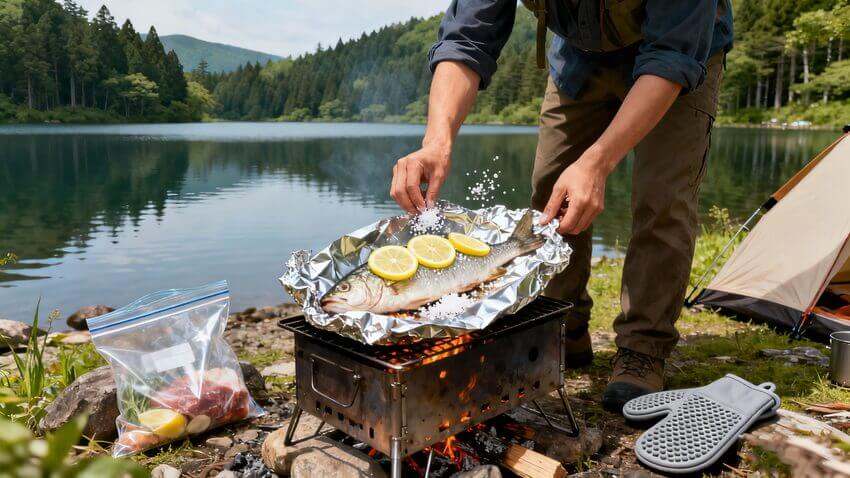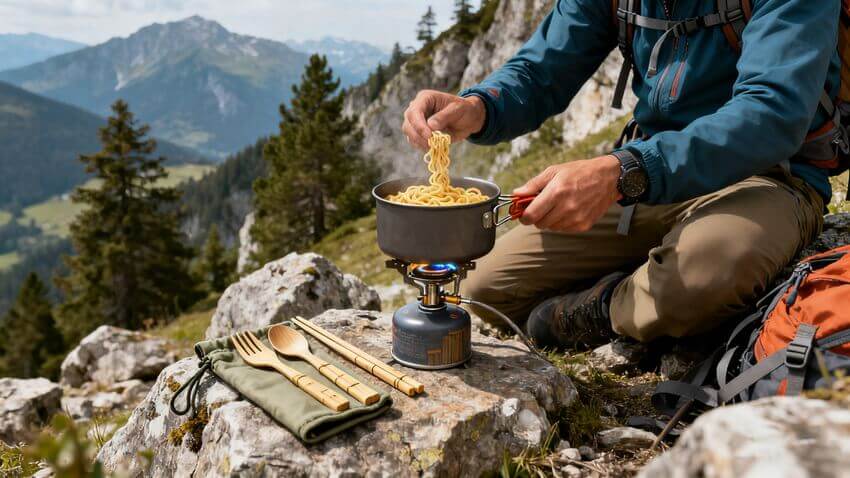![]() Windy.
Windy.
 WeChat
WeChat
 WhatsApp
WhatsApp
Click:1 seen
In outdoor expeditions abroad, the provision of food and the selection of utensils directly affect the experience. One must deal with environmental restrictions in different regions while also considering convenience and safety. It is necessary to combine local resources and practical equipment to efficiently meet the dietary needs.
I. Solving the Food Problem: A Complete Process Plan from Planning to Handling
1. Advance Planning: Adaptation to Region and Trip
Short-distance lightweight exploration (such as a single-day mountain hiking in Europe): Use "ready-to-eat food" mainly, such as freeze-dried soup from Germany and ready-to-eat pasta from Italy. Boil water and heat for 5 minutes to eat, no complex operations required.
Long-term camping (such as multi-day camping in North American national parks): Adopt the "pre-prepared ingredients + fresh supplements" model. Prepare beef and chicken at home in vacuum packaging in advance, combined with locally available storable vegetables (onions, bell peppers), reducing the pressure of long-distance carrying.
Special environmental response: In Nordic cold-weather exploration, carry high-energy-density "compressed meat jerky" and "concentrated chocolate sauce" to quickly replenish calories; in Australian desert areas, prioritize dehydrated rice and canned fish, avoiding reliance on refrigeration and preventing food spoilage.
2. Local Resource Utilization: Rational Use of Regional Resources
Waterfront areas: When camping in Hokkaido, Japan or the Great Lakes region of North America, you can catch freshwater fish and wrap them in tin foil, combined with the lemon slices and salt you bring with you, roast on the fire pit, fresh and no need for additional carrying; when exploring the rainforest in Southeast Asia, pick local edible wild vegetables (need to learn the identification knowledge in advance), combine with pre-prepared sauces to make soup, enriching the taste.
Risk Avoidance: Strictly follow local regulations, such as in African grasslands, do not randomly pick plants, in some European countries, there are "licensing requirements" for outdoor fishing, avoiding affecting the trip due to material collection violations.

3. Efficient Handling: Simplified Operations and Reducing Waste
Food Preprocessing: Before departure, cut vegetables and pack them in sealed boxes, no additional processing is required outdoors; use "multi-functional cutting board" (with storage compartments), cut and then directly store, reducing the use of utensils.
Remaining Food Handling: Seal and refrigerate the leftover cooked food (if the campsite has a refrigerator), or make "mixed soup" (such as leftover meat + vegetables cooked into soup), avoiding waste and simplifying the cooking for the next meal.

II. Selecting Convenient Utensils: Lightweight and Multi-functional Priority
1. Core Utensils: Adapted to Outdoor Scenarios
Stove: For European mountain exploration, choose "alcohol stove" (fuel easy to carry and in line with mountain regulations); for North American self-driving camping, bring "card-type gas stove + large capacity gas tank", with sufficient power, suitable for multiple people to cook; for single-person lightweight hiking, choose "mini solid alcohol stove", small in size like the palm, weighing only 50 grams.
Cookware: Prefer "titanium alloy folding pot", with an unfolding capacity of 1.5 liters, after unfolding, the thickness is less than 3 centimeters; for multi-person camping, bring "layered steamer", the upper layer steams vegetables, the lower layer cooks the main food, one pot for multiple uses, reducing the number of equipment.
Utensil Set: The popular "bamboo portable set" in Europe and America (including forks, spoons, chopsticks, with a storage bag), lightweight and environmentally friendly; or choose "stainless steel multi-functional utensils" (the end of the fork can be used as a bottle opener, the spoon can be used as a scraper), one tool for multiple uses, reducing the number of carrying items.

2. Auxiliary Tools: Enhancing Efficiency and Safety
Storage: Bring "silicone folding bowl" (can be compressed to the size of a coin), used for soups or portioning food; use "sealed storage bags" (select thick models), can store ingredients and also serve as a temporary "washing basin", reducing the carrying of dedicated containers.
Safety: Bring "food-grade silicone heat insulation gloves" to avoid burns when heating the pot; in areas with wildlife presence (such as Yellowstone National Park in North America), bring "bear-proof food storage bucket", store utensils and food together to prevent being damaged by animals.

3. Purchase Tips: Focus on Portability and Compliance
Check regional standards: Some European countries have specific "emission standards" for outdoor stoves, so choose products that are certified by the EU CE; in North American campsites, there are specific requirements for gas tank types (such as prohibiting the use of high-pressure gas tanks), so make sure to confirm these in advance to avoid incompatibility.
Weight Control: The weight of single-person dining sets should be kept under 200 grams, and multi-person sets (including stoves and cookware) should not exceed 3 kilograms to avoid increasing the burden on the hike.
The core of choosing food and tableware for outdoor adventures abroad is "tailoring to the local conditions" - combining the local environment, the duration of the trip, and local regulations to solve the dietary needs with a simple solution, and enhancing the travel efficiency with lightweight equipment, making outdoor dining both convenient and enjoyable.
